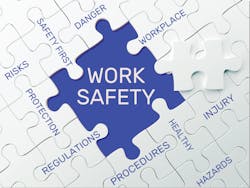The critics of behavior-based safety (BBS) and the proponents of human and organizational performance (HOP), who are often the same folks, continue to find fault with what they consider the basic premises of BBS and what they assume to be the common methodology. First, remember how the word “assume” can get you into trouble. Next, let’s take a look at how a lot of BBS processes missed the boat that HOP launched.
To the first point, not all BBS processes are the same. There are differences across almost all the components of the process. The governance of the process varies all the way from management-driven, to worker-led, to unled. The selection of behaviors on checklists varies from brainstorming to Pareto analysis of past incident data. The number of behaviors on a checklist (based on the 1600+ checklists I have seen) varies from 2-74. Observation strategies vary from “everyone do one per month” to a select few observers using a sophisticated sampling strategy. Feedback strategies vary from confrontation to peer coaching. Observation data gathering varies from crude to high-tech. Utilization of observation data varies from ignoring the data to rather sophisticated analysis and development of action plans to address influences on behaviors.
The most sophisticated of these processes addresses the majority of issues included in a HOP initiative. But let’s look at the less sophisticated processes and where they fall short.
Behavioral Focus. Many BBS processes determine their behavioral focus in very non-scientific ways. Some adopt checklists from other processes or sites, assuming the behaviors that can prevent accidents there were the same here. Very few processes realized at first that every site is likely different and needs to determine the behavioral focus through analysis of site accident and near-miss data. Almost universally, checklists include too many behaviors to successfully address all at once.
Observation Strategy. Most involve two objectives: gathering data and giving feedback.
Data Gathering. The first task of gathering data on behaviors is to determine which behaviors to observe. Selecting behaviors that could potentially make the greatest difference in accidents was sometimes guesswork and sometimes based on analysis of past incidents. The remaining issues were whether to define at-risk behaviors to discourage or safe behaviors to reinforce, and how many behaviors to address at a time. When behaviors are observed, do observers record the number of safe observations, the number of unsafe observations, or the ratio of one to the other? The best processes use this data gathering to determine what influenced observed behaviors.
Giving Feedback. Weak BBS processes blindly accepted Heinrich’s assertion that the majority of accidents come from the unsafe behaviors of workers. Following this flawed logic led to thinking that these risky behaviors were in the control of workers and that simply giving feedback could change these behaviors. So, many BBS processes were trying to fix the worker instead of fixing the problem. The assumption that workers controlled all these behavioral choices ignores the whole concept of influences. Bad processes tried to positively reinforce safe behaviors and confronted workers and told them to stop unsafe behaviors; better processes also positively reinforced the taking of precautions and expressed concern over unsafe acts and asked why they happened. This form of feedback was more effective and identified the influences on risks for further analysis and actions. If certain behaviors were reinforced by influences from the work environment, the culture, leadership or other factors, then feedback was a very small influence compared to all these others.
Utilizing Observation Data. Weak BBS processes simply addressed observation data by increasing the amount of feedback or providing re-training or other reminders in the workplace to try to address behaviors not responding to feedback. Some processes did nothing with observation data except track progress or the lack of it. Some proponents of these BBS methodologies even asserted that the majority of “good” came from the interaction of the observer and the worker and did not find the utilization of observation data particularly useful. The best processes used the comments from observations describing what influenced the behaviors. They developed action plans to address the influences and track how the behaviors reacted to these action plans.
Addressing SIFs. HOP proponents have been critical of BBS for not reducing serious accidents and fatalities (SIFs) as effectively as it reduces less-severe accidents. In some instances, this was by design. Sites with mature traditional processes had often eliminated the majority of their serious accidents and wanted to use BBS to mop up the minor accidents that remained. Others were convinced by Heinrich thinking that reducing the risks at the bottom of the pyramid would equally address accidents at the top of the pyramid in proportion to their occurrence, regardless of severity. Still others decided to address their SIFs with special emphasis on rules and procedures that addressed their most dangerous risks such as lockout/tagout or confined space entry. These were called life-saving rules, cardinal rules, or a number of other labels.
The real issues that challenge using BBS to address SIFs are:
• The experts do not yet agree on a list of behaviors that address SIFs specifically and are focusing efforts on identifying potential SIFs, or PSIFs. Many of the researchers on SIFs suggest that Heinrich’s pyramid should have a thinner pyramid up the middle which they claim is the part that impacts SIFs. However, a number of fatalities and serious injuries each year come from the same pool of behaviors that contribute to more common accidents.
• Research is showing that most of the decisions that lead to SIFs are made by those who manage or supervise rather than by the worker.
While some approaches to BBS were ineffective, not all were. There are organizations that implemented BBS very effectively and had great and lasting results. Anything can be done poorly but that does not necessarily mean it is ineffective or hopelessly flawed. Is your BBS process done right?
